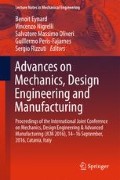Abstract
Additive manufacturing (AM) has enabled the building of parts with new shapes and geometrical features. As this technology modifies the practices, new knowledge is required for designing and manufacturing properly. To help experts create and share this knowledge through formalization, our paper focusses on testing three knowledge elicitation techniques. After defining knowledge concepts we present the State of Art in knowledge elicitation and a methodology. A case study about support creation for AM points out: the assets and limits of the techniques; the different types of knowledge elements per technique; some contradictions between experts. We finally propose collective tools for a better elicitation and formalization of AM knowledge.
Access this chapter
Tax calculation will be finalised at checkout
Purchases are for personal use only
Preview
Unable to display preview. Download preview PDF.
References
Markus LM. Toward a Theory of Knowledge Reuse: Types of Knowledge Reuse Situations and Factors in Reuse Success. J Manag Inf Syst, 2001,18:57–93
Gardan N. Knowledge Management for Topological Optimization Integration in Additive Manufacturing. Int J Manuf Eng, vol:2014
Wilson TD. The nonsense of knowledge management. Inf Res 2002, 8:paper 144
Nonaka I, Takeuchi H. The Knowledge-Creating Company: How Japanese Companies Create the Dynamics of Innovation.Oxford University Press, 1995.
Polanyi M. The Tacit Dimension. London, Routledge & K. Paul, 1967.
Mougin J, Boujut J-F, Pourroy F, Poussier G. Modelling knowledge transfer: A knowledge dynamics perspective. Concurrent Engineering, 2015, 23(4), 308-319.
Cooke NJ. Varieties of knowledge elicitation techniques. Int J Hum-Comput Stud 1994, 41:801–49
Milton NR. Knowledge Acquisition in Practice: A Step-by-step Guide. Springer Science & Business Media, 2007.
Stenzel I, Pourroy F. Integration of experimental and computational analysis in the product development and proposals for the sharing of technical knowledge. Int. J. Interact. Des. Manuf, 2008, 2(1), 1–8.
Author information
Authors and Affiliations
Corresponding author
Editor information
Editors and Affiliations
Rights and permissions
Copyright information
© 2017 Springer International Publishing AG
About this chapter
Cite this chapter
GRANDVALLET, C., POURROY, F., PRUDHOMME, G., VIGNAT, F. (2017). Testing three techniques to elicit additive manufacturing knowledge. In: Eynard, B., Nigrelli, V., Oliveri, S., Peris-Fajarnes, G., Rizzuti, S. (eds) Advances on Mechanics, Design Engineering and Manufacturing . Lecture Notes in Mechanical Engineering. Springer, Cham. https://doi.org/10.1007/978-3-319-45781-9_29
Download citation
DOI: https://doi.org/10.1007/978-3-319-45781-9_29
Published:
Publisher Name: Springer, Cham
Print ISBN: 978-3-319-45780-2
Online ISBN: 978-3-319-45781-9
eBook Packages: EngineeringEngineering (R0)

